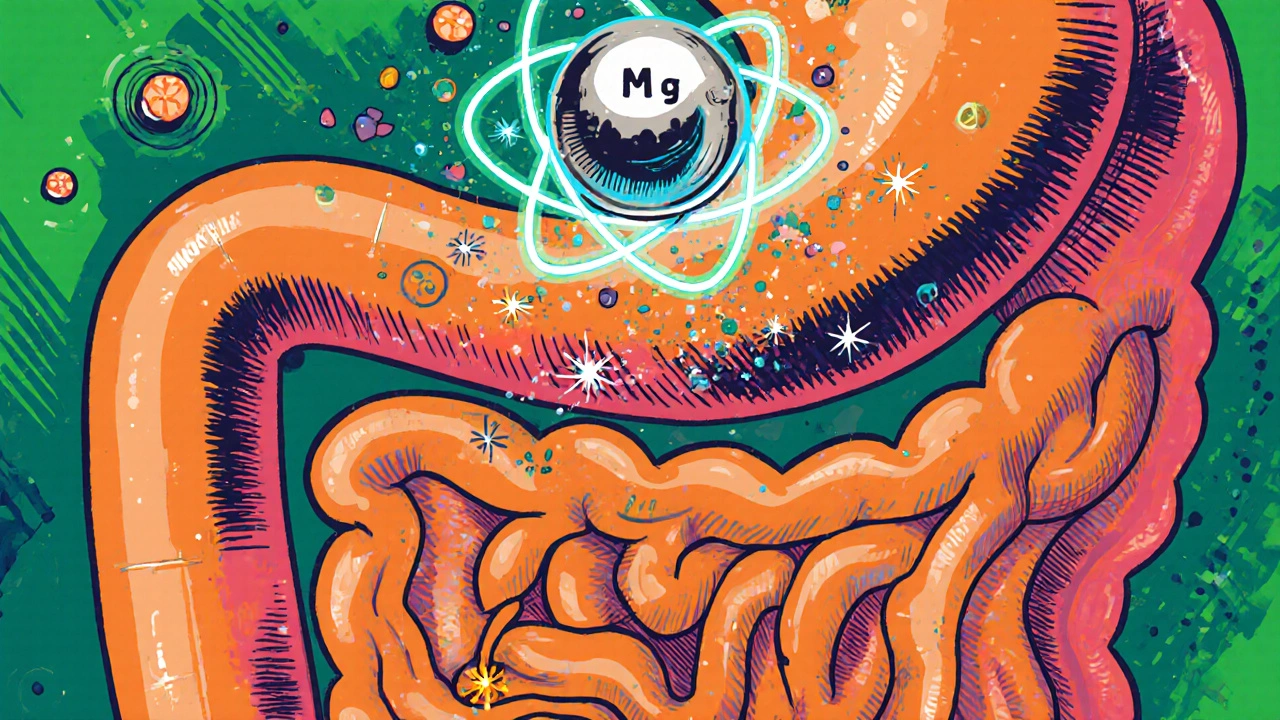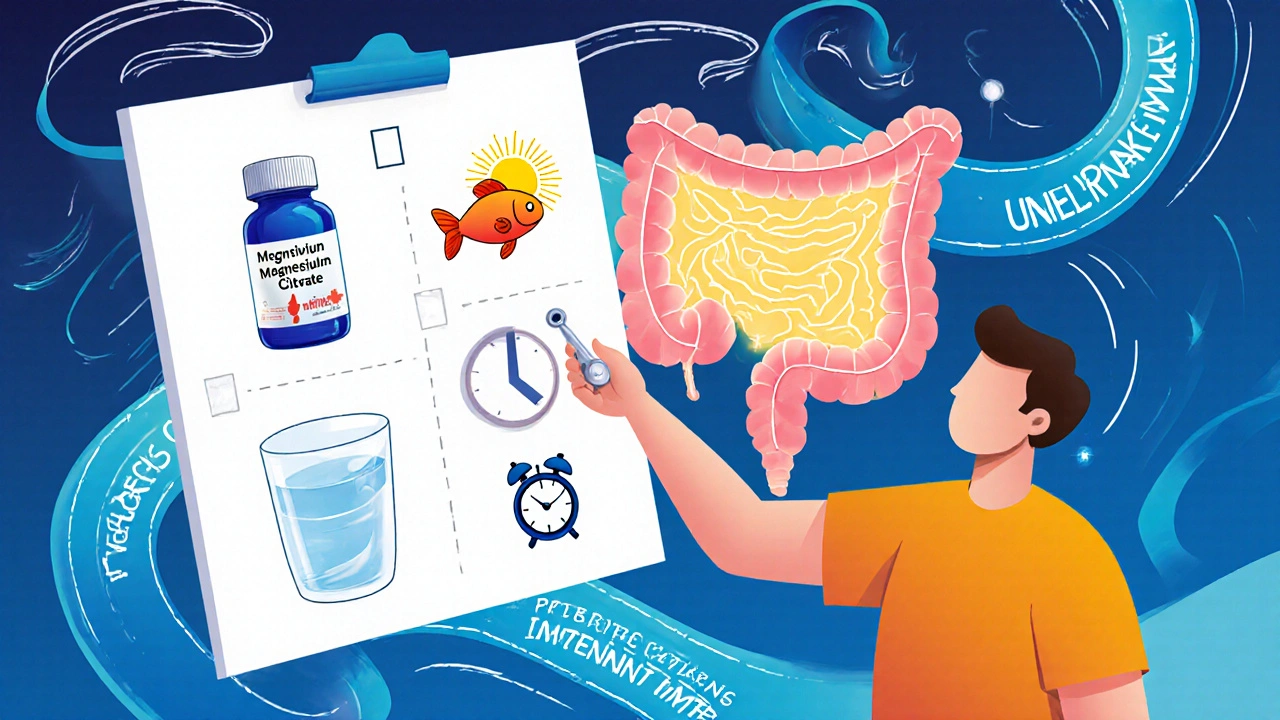
Magnesium Absorption Calculator
Calculate Your Magnesium Absorption
Your Magnesium Absorption
Your calculation is loading...
Recommendations will appear here based on your input
When it comes to getting the most out of what you eat, one mineral often flies under the radar: magnesium. This mineral does more than keep your muscles relaxed; it plays a pivotal role in how efficiently your gut extracts nutrients from food.
Magnesium is a silvery-white alkaline earth metal essential for over 300 biochemical reactions, including ATP production, DNA synthesis, and muscle contraction. The human body cannot produce magnesium, so dietary intake or supplementation is the only source.Inadequate magnesium levels can set off a cascade that impairs digestion, slows enzyme activity, and even alters the gut microbiome-all of which contribute to poor nutrient absorption. Below we’ll break down why magnesium matters, how it interacts with other nutrients, and practical steps you can take to keep your absorption game strong.
Why Magnesium Matters for Digestion
Magnesium’s influence on the digestive system can be grouped into three core mechanisms:
- Enzyme activation. Many digestive enzymes-especially those that break down proteins and carbohydrates-require magnesium as a co‑factor. Without enough magnesium, enzymes work slower, leaving nutrients partially digested.
- Muscle tone in the gastrointestinal (GI) tract. Magnesium relaxes smooth muscle, helping peristalsis move food efficiently. Low magnesium can lead to spasm, sluggish transit, and bacterial overgrowth.
- Gut microbiota balance. Research from the University of Exeter (2023) showed that magnesium‑rich diets boosted beneficial Bifidobacteria by 18% while suppressing harmful Clostridia.
Magnesium’s Interaction with Other Key Nutrients
Magnesium doesn’t work in isolation. Its relationship with calcium, vitamin D, zinc, and fiber can tip the scales between optimal absorption and malabsorption.
- Calcium vs. Magnesium. These two minerals compete for the same transport channels in the intestines. A calcium‑to‑magnesium ratio of roughly 2:1 is generally recommended to avoid interference.
- Vitamin D. Vitamin D enhances magnesium absorption in the small intestine. In turn, magnesium is needed to convert vitamin D into its active form (calcitriol), creating a feedback loop.
- Zinc and Iron. High doses of zinc or iron can hinder magnesium uptake. Staggering supplement timing by at least two hours mitigates this effect.
- Dietary Fiber. Soluble fiber forms a gel that can bind magnesium, reducing its bioavailability. However, insoluble fiber (found in whole grains) actually aids magnesium absorption by improving gut motility.
Common Causes of Magnesium‑Related Malabsorption
Even if you eat magnesium‑rich foods, certain conditions can still limit absorption:
- Chronic diarrhea or laxative abuse - reduces transit time, giving the gut less opportunity to soak up magnesium.
- Inflammatory bowel diseases (Crohn’s, ulcerative colitis) - inflamed mucosa loses transport proteins.
- Long‑term use of proton‑pump inhibitors (PPIs) - lowers stomach acidity, which is needed to release magnesium from food complexes.
- Kidney disorders - excess urinary loss can deplete body stores, triggering secondary malabsorption.

Top Magnesium‑Rich Foods and Their Bioavailability
| Food Item | Mg (mg per 100 g) | Typical Absorption % | Key Benefits |
|---|---|---|---|
| Spinach (cooked) | 79 | 30‑40 | High iron, vitamin K |
| Almonds | 270 | 25‑35 | Healthy fats, vitamin E |
| Black beans | 120 | 30‑45 | Protein, fiber |
| Quinoa (cooked) | 64 | 35‑45 | Complete protein |
| Cashews | 292 | 20‑30 | Mineral blend (copper, zinc) |
| Avocado | 29 | 40‑50 | Potassium, monounsaturated fats |
The absorption percentages vary because of phytate content, fiber type, and cooking method. Soaking beans, sprouting grains, or lightly sautéing greens can cut phytate levels and boost magnesium uptake by 10‑15%.
Choosing the Right Magnesium Supplement
If diet alone isn’t enough, supplements can fill the gap-but not all forms are created equal.
- Magnesium citrate. One of the most bioavailable salts (≈30‑40% absorption). Good for general support and occasional constipation.
- Magnesium glycinate. Chelated with glycine; absorption >40%, gentle on the stomach. Ideal for those with sensitive GI tracts.
- Magnesium oxide. High elemental Mg but low absorption (<10%). Better suited for short‑term laxative use, not long‑term nutrition.
- Magnesium threonate. Penetrates the blood‑brain barrier; emerging evidence suggests cognitive benefits, though data on gut health are limited.
Daily supplemental doses between 200‑400 mg are safe for most adults, but exceeding 350 mg from supplements alone can cause diarrhea, which paradoxically worsens nutrient loss.
Practical Strategies to Boost Magnesium‑Mediated Absorption
- Space out mineral supplements. Take magnesium at a different time than calcium, zinc, or iron to avoid competition.
- Pair with Vitamin D‑rich foods. Fatty fish, fortified milk, or a brief sun exposure helps convert dietary magnesium into its active form.
- Incorporate probiotic‑rich foods. Yogurt, kefir, and fermented vegetables increase gut bacteria that synthesize short‑chain fatty acids, which improve mineral transport.
- Limit high‑phytate meals. If you’re eating a lot of whole grains, soak or ferment them to reduce phytate binding.
- Avoid chronic use of PPIs. Discuss alternatives with your doctor if you rely on acid reducers for more than six months.

Monitoring Your Magnesium Status
Blood serum magnesium is a rough indicator; only about 1% of total body magnesium circulates in blood. More reliable methods include:
- Red blood cell (RBC) magnesium. Reflects intracellular stores and is less influenced by short‑term diet changes.
- Magnesium loading test. A 24‑hour urinary excretion test after a magnesium bolus; low excretion suggests deficiency.
Typical reference ranges: serum 1.7-2.2 mg/dL, RBC 4.2-6.8 mg/dL. If you fall below these, consider dietary tweaks or a targeted supplement.
Quick Checklist: Ensuring Optimal Magnesium‑Supported Absorption
- Eat at least three magnesium‑rich foods daily (e.g., nuts, leafy greens, legumes).
- Take 200‑400 mg of a highly absorbable supplement if diet falls short.
- Consume Vitamin D sources (sunlight, fish, fortified milk) alongside magnesium.
- Space out other mineral supplements by 2 hours.
- Incorporate probiotic foods 3‑4 times a week.
- Check RBC magnesium levels if you have chronic GI issues.
Frequently Asked Questions
Can I get enough magnesium from a vegetarian diet?
Yes. Foods like spinach, beans, nuts, seeds, and whole grains provide ample magnesium. Pair them with Vitamin D‑rich sources and avoid heavy phytate binding by soaking or sprouting.
Does coffee or tea affect magnesium absorption?
Caffeine can increase urinary magnesium loss, especially when intake exceeds 300 mg per day. Moderation (1-2 cups) is fine, but balance with magnesium‑rich foods.
How long does it take to see improvement in nutrient absorption after raising magnesium levels?
Most people notice better regularity and less bloating within 2-4 weeks of consistent magnesium intake, though full enzymatic benefits may take 6-8 weeks.
Is it safe to take magnesium supplements while on blood pressure medication?
Generally, yes-magnesium can help lower blood pressure. However, some diuretics increase magnesium loss, so monitor levels with your doctor.
What’s the difference between magnesium citrate and glycinate?
Citrate is highly soluble and good for occasional constipation; glycinate is chelated with an amino acid, offering higher absorption and less laxative effect.
Bottom line: Magnesium is a linchpin in the complex orchestra that turns food into usable fuel. By eating magnesium‑rich foods, choosing the right supplement, and paying attention to related nutrients, you can keep your gut humming and avoid the frustrating cycle of malabsorption.






Mike Peuerböck
October 23, 2025 AT 20:10Boost your gut with magnesium and feel the difference!
Simon Waters
October 24, 2025 AT 12:00The big pharma lobby hides the real power of magnesium. It’s all part of the control agenda.
Celeste Flynn
October 25, 2025 AT 01:53Magnesium acts as a co‑factor for many digestive enzymes and helps relax intestinal smooth muscle which improves peristalsis. It also supports a healthy gut microbiome by encouraging beneficial bacteria. Adequate intake can therefore reduce malabsorption symptoms.
CASEY PERRY
October 25, 2025 AT 15:46From a mechanistic perspective magnesium chelates with ATP to phosphorylate enzymes involved in carbohydrate hydrolysis, thereby augmenting Vmax of amylase activity. Additionally it modulates calcium‑sensing receptors in enterocytes, influencing paracellular transport.
prithi mallick
October 26, 2025 AT 04:40Great insight thank you so much i totally agree that a balanced diet is key. If you ever feel low on magnesum just remember to add some leafy greens or nuts they can really help.
Michaela Dixon
October 26, 2025 AT 18:33Magnesium is truly a cornerstone of nutritional health and its impact on the digestive system cannot be overstated. When you consume magnesium‑rich foods such as spinach, almonds, or black beans you are not only providing your body with a vital mineral but also supporting the complex enzymatic cascade that breaks down proteins and carbohydrates. Each enzyme that participates in these processes often requires magnesium as an essential co‑factor, meaning that insufficient levels can slow the rate at which nutrients are converted into absorbable forms. Moreover magnesium’s role in smooth muscle relaxation facilitates peristalsis, the wave‑like contractions that move food through the gastrointestinal tract. Without adequate magnesium, the intestine may experience spasms or sluggish transit, which can lead to bacterial overgrowth and diminished nutrient uptake. The synergy between magnesium and other micronutrients further amplifies its importance; for instance vitamin D enhances magnesium absorption while magnesium is needed to activate vitamin D into its hormonal form. In addition, an optimal calcium‑to‑magnesium ratio of about 2:1 helps prevent competition for intestinal transport channels, ensuring both minerals are efficiently utilized. It’s also noteworthy that high doses of zinc or iron can interfere with magnesium uptake, so spacing supplement timing by a couple of hours is advisable. Dietary fiber presents a dual effect: soluble fiber can bind magnesium and reduce its bioavailability, whereas insoluble fiber improves gut motility, indirectly supporting magnesium absorption. Lifestyle factors such as chronic diarrhea, use of proton‑pump inhibitors, or certain kidney disorders can further compromise magnesium status, leading to secondary malabsorption issues. To counteract these challenges, you might consider magnesium citrate or glycinate supplements, which are known for their higher bioavailability and gentler impact on the stomach. Regularly incorporating magnesium‑rich foods and mindful supplementation can thus protect against nutrient deficiencies and promote overall digestive wellness. Ultimately, by paying close attention to magnesium intake you empower your body to extract the maximum benefit from every meal you enjoy.
Dan Danuts
October 27, 2025 AT 08:26Love this deep dive! Keep sharing the good vibes and magnesium tips!
Dante Russello
October 27, 2025 AT 22:20For anyone looking to optimize nutrient uptake, consider assessing your magnesium status, especially if you’re on a high‑fiber diet, take proton‑pump inhibitors, or experience chronic gastrointestinal symptoms, because magnesium deficiency can silently undermine absorption, and addressing it with targeted foods or well‑chosen supplements can dramatically improve overall health outcomes.